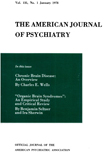THE THERAPEUTIC USE OF PROLONGED SODIUM AMYTAL NARCOSIS
Abstract
During the past 8 years we have used prolonged sodium amytal narcosis in the treatment of border-line neuropsychiatric disorders. The therapeutic technique is usually so planned as to produce a toxic delirium after the cessation of drug administration. This therapeutic delirium is judged to be reliably restorative and reconstructive. Various degrees of narcoanalysis and narcosynthesis are permitted, but most benefit follows delirious abreaction. All patients to whom the treatment was administered were helped, some more than others. Dissolution of the faulty personality behavior and constructive recasting of the psychiatric problem probably occur through improved physiological rest and a remobilization of thought processes during an irresponsible and impersonal state of psychomotor activity which is temporarily out of volitional control, and is thereafter always reintegrated at a more acceptable level.
Access content
To read the fulltext, please use one of the options below to sign in or purchase access.- Personal login
- Institutional Login
- Sign in via OpenAthens
- Register for access
-
Please login/register if you wish to pair your device and check access availability.
Not a subscriber?
PsychiatryOnline subscription options offer access to the DSM-5 library, books, journals, CME, and patient resources. This all-in-one virtual library provides psychiatrists and mental health professionals with key resources for diagnosis, treatment, research, and professional development.
Need more help? PsychiatryOnline Customer Service may be reached by emailing [email protected] or by calling 800-368-5777 (in the U.S.) or 703-907-7322 (outside the U.S.).



